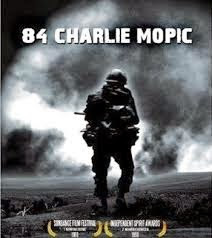Saving Charlie MoPic

War movies continue to attract audiences, as the strong box office for Fury makes clear. On Veterans Day 2014, I want to remember the war that tore my own generation to shreds: Vietnam. Though Hollywood’s first response to the Vietnam conflict was John Wayne’s flag-waving 1968 flick, The Green Berets, the following decades brought cinematic reassessments of America’s role via The Deer Hunter (1978), Apocalypse Now (1979), and Platoon (1986) Those films all featured major stars and won prestigious awards, including multiple Oscars. But today I’d like to salute an indie, 84 Charlie MoPic. Shot on a shoestring in Southern California, it has been hailed by Nam veterans as a truly realistic depiction of a grunt’s life.
Made under the auspices of the Sundance Institute, 84 Charlie MoPic cleverly finesses its low budget by pretending to be documentary footage shot by a young recruit from the U.S. Army’s motion picture unit. His subject is a reconnaissance patrol operating behind enemy lines. As he conducts in-the-field interviews with five tight-knit platoon members as well as the eager new lieutenant who sees war as an opportunity for his own advancement, we get an increasingly graphic view of the stresses and strains of combat. The cameraman, known in military parlance as MoPic, at one point hints at his own role in this subjective-camera saga: “I was working in a lab, back in the rear -- post-production. Sometimes we would get these cans of film in, you know? No cameraman, just the reels of film. And, we hear he got shot, he's dead or something. But the spookiest thing is waiting for that film to develop, man, because you didn't know what you were gonna see. Sometimes you saw nothing. But other times . . . “
A fan on the IMDB site gives credit for 84 Charlie MoPic’s authenticity to the film’s two technical advisors, Russ Thurman and Dale Dye, both of whom served in the Marine Corps. As he explains, “Dye's method of running the actors through a mini-boot camp helps raise this film to the level of Platoon and Saving Private Ryan, his more widely-known achievements.” But it’s hardly fair to forget the film’s writer-director, Patrick Sheane Duncan, whom I had the privilege of interviewing once upon a time.
Pat, like so many in Hollywood, was a Roger Corman alumnus. He started out as an accountant, though one who aspired to write. Vietnam was his first big subject. Too poor to go to college, he’d enlisted in the Army in 1965. For fifteen months from 1968 through 1969 he served in the 173rdAirborne Brigade. Once he returned home, he was determined to tell the truth about his combat experience, which was a far cry from the sentimental pap he saw on movie screens. Pat pointed out to me that Charlie MoPic and his later Vietnam films were distinct because “they weren’t about the war. They were about the soldiers. I tried to make them more intimate.” He well remembers that “when we showed MoPic at Sundance, some kid came up to me . . . and he says, ‘I didn’t realize it but sometimes when people die, they don’t get any last words.’ That’s because in all those war movies we saw, the guy layin’ there had a nice speech about ‘Tell my mom. . . .’”
For a filmmaker with such a powerful perspective on men at war, Pat Duncan’s public reputation rests on something quite different. In 1995 he wrote a quiet little film that paid tribute to a dedicated music teacher. Nobody dies in Mr. Holland’s Opus.
Published on November 11, 2014 09:38
No comments have been added yet.
Beverly in Movieland
I write twice weekly, covering topics relating to movies, moviemaking, and growing up Hollywood-adjacent. I believe that movies can change lives, and I'm always happy to hear from readers who'd like t
I write twice weekly, covering topics relating to movies, moviemaking, and growing up Hollywood-adjacent. I believe that movies can change lives, and I'm always happy to hear from readers who'd like to discuss that point.
...more
- Beverly Gray's profile
- 10 followers



